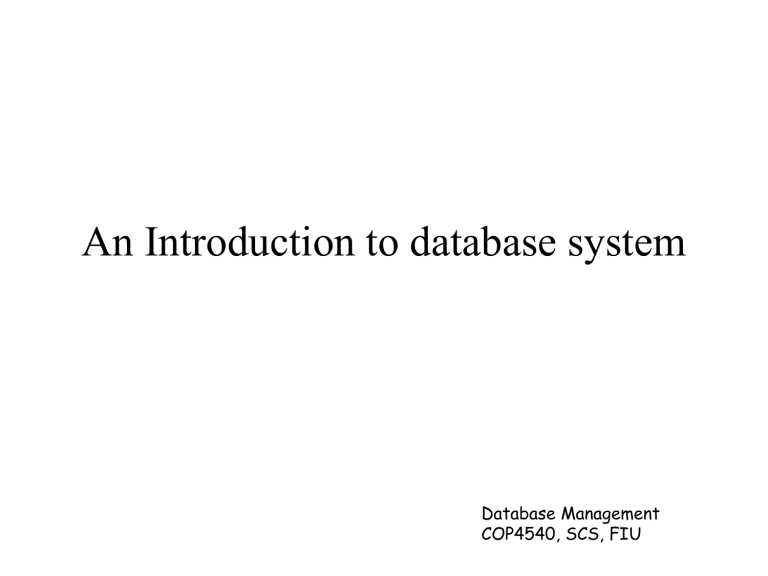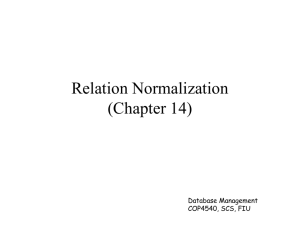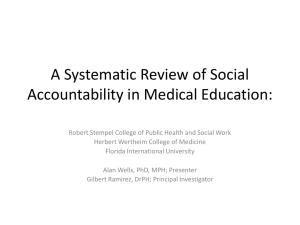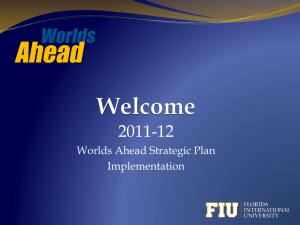What is a Database Management System?

An Introduction to database system
Database Management
COP4540, SCS, FIU
Basic Definitions
• Data: Meaningful facts, text, graphics, images, sound, video segments.
• Database: An organized collection of logically related data.
• Information: Data processed to be useful in decision making.
• Metadata: Data that describes data.
Database Management
COP4540, SCS, FIU
What is a DataBase system?
(DB)
• It is a logically coherent collection of data with inherent meaning.
• It represents a miniworld, and should represent the state of that world accurately.
• It is managed by a database management system (DBMS).
Database Management
COP4540, SCS, FIU
What is a DataBase Management System?
(DBMS)
• A (large) piece of software which provides an interface between the user or application program and the stored data.
• A DBMS is developed according to a particular data model.
• Some example DBMSs are:
– IMS, DB2, Oracle, Sybase, Informix, SQL
Server, Access, FoxPro, O2.
Database Management
COP4540, SCS, FIU
The functionality of DBMS
• Manages very large amounts of data.
• Supports efficient access to very large amounts of data.
• Supports concurrent access to very large amounts of data.
• Supports secure, atomic access to very large amounts of data.
Database Management
COP4540, SCS, FIU
Several basic concepts
• Data models
– A data model is a way of representing (part of) the world.
– The principle current data model are:
• Hierarchical
• Network
• Relational
• Object-oriented
• E-R
• Semantic
Database Management
COP4540, SCS, FIU
Several basic concepts
• Database design
– Design goals
• Minimize redundancy in order to eliminate the modification anomalies in database.
• Represent the situation accurately
– Design Stages
• Conceptual (product independent)
• Logical (product specific)
• Physical / Implementation (product specific)
Database Management
COP4540, SCS, FIU
Database Development Activities
Enterprise Modeling
Conceptual Data Modeling
Logical DB Design
Physical DB Design
}
The stages focused in COP4540
DB Implementation
DB Maintenance
Database Management
COP4540, SCS, FIU
Conceptual Database Modeling
• Determine user requirements.
• Determine business rules.
• Build conceptual data model
– outcome is an entity-relationship diagram or similar communication tool.
Database Management
COP4540, SCS, FIU
Logical Database Design
• Select logical database model.
• Map Entity-Relationship Diagrams
• Normalize data structures.
• Specify business rules.
Database Management
COP4540, SCS, FIU
Physical Database Design
• Select DBMS
• Select storage devices
• Determine access methods
• Design files and indexes
• Determine database distribution
• Specify update strategies
Database Management
COP4540, SCS, FIU
Several basic concepts
• Schema
– Logical structure of the data defined by using data definition language (DDL).
• Queries
– A “query” is a database lingo for a question about the data.
– A “query” is composed by using query language (QL)
Database Management
COP4540, SCS, FIU
The architecture of database system
Users / Programmers
Application Programs / Queries
Database Management System
1. Software to process queries/programs
2. Software to access stored data
Stored data
Database Management
COP4540, SCS, FIU
Components of the Database Environment
• CASE Tools
• Repository
• Database Management System (DBMS)
• Database
• Application Programs
• User Interface
• Database Administrators (DBA)
• System Developers
• End Users
Database Management
COP4540, SCS, FIU
Evolution of Database Systems
• Hierarchical and Network (Legacy): Data are modeled as linked records.
• Relational: Data are modeled as related tables.
• Object-oriented: Data are organized as linked objects.
– Object-relational: Integration of relational and object-oriented features.
Database Management
COP4540, SCS, FIU
RDBMS and SQL
• RDBMS is a DBMS on the basis of relational model.
• It is the most popular type of the DBMS.
• The data is organized as tables called relations
• Two famous systems:
–
System R at IBM & Ingres at UC Berkeley
• SQL (Structured Query Language)
– the most important query language based on relational model.
Database Management
COP4540, SCS, FIU
RDBMS and SQL
Accounts accountNo balance
12345
67890
1000.00
2846.92
type savings checking
SELECT balance
FROM Accounts
WHERE accountNo = 67890
Result:
2846.92
Database Management
COP4540, SCS, FIU
Disadvantages of File Processing
Systems
• Data Dependence
• Data Redundancy (Duplication of data)
• Limited Data Sharing
• Lengthy Development Times
• Excessive Program Maintenance
Database Management
COP4540, SCS, FIU
Advantages of Database Approach
• Program-Data Independence: No need to rewrite programs when data is modified
• Minimal Data Redundancy
• Improved Data Consistency
• Improved Data Sharing
• Increased Application Development
Productivity.
Database Management
COP4540, SCS, FIU
Advantages of Database Approach
• Enforcement of Standards
• Improved Data Quality (Constraints)
• Better Data Accessibility/Responsiveness
• Reduced Program Maintenance
• Security, Backup/Recovery, Concurrency
Database Management
COP4540, SCS, FIU
Costs and Risks of the Database
Approach
• New, Specialized Personnel
• Installation Management Cost and
Complexity
• Conversion Costs
• Organizational Conflict
Database Management
COP4540, SCS, FIU









